Microsoft ends CES keynote run with Windows 8 focus
Software company's final (for now) Las Vegas tech show light on gaming news; Kinect hits PCs February 1 as Xbox 360 user base tops 66 million.
LAS VEGAS--There are those who believe that Microsoft will drop the mic in its final 2012 Consumer Electronics Show appearance, after bringing down the house with the first official word of the oft-rumored Next Xbox. This speculation comes despite the Xbox 360 still being the dominant console in North America, from both a hardware and software sales perspective.

While a full console unveil is a bit of a long shot, Microsoft is likely to have a few announcements up its sleeve for CES 2012. As it pertains to the company's Xbox division, updated statistics for its console and the Xbox Live online network are safe bets, along with new initiatives on bringing original television to its entertainment box. And on the fringe of possibility, Microsoft could use its limelight to trot out a new hardware iteration for the Kinect.
Unofficially dubbed the Kinect 2, the device is said to be sophisticated enough to read lips. Rumors also suggest that the motion-sensing peripheral can assess a player's emotional state and determine which direction he or she is facing. Of course, those same rumors suggest the Kinect 2 will be a key part of Microsoft's next console.
Beyond the Xbox 360, Microsoft will likely talk about its new operating system Windows 8, as well as advances on the Windows Phone front.
[6:29] Microsoft's final CES keynote address is supposed to be just seconds away!
[6:32] Gary Shapiro, president of the CES-organizing CEA, takes the stage to welcome the crowd to the keynote address.
[6:33] Shapiro reminisces about the first time Bill Gates delivered a Microsoft address at CES.
[6:33] In 1995, Gates talked about the coming computing revolution, emphasizing that it would be "social."
[6:34] Shapiro acknowledges that "Microsoft is taking a break from the keynote stage" in 2013.
[6:36] He talks about the need to keep things fresh and change things, but thanks Microsoft for its support in years past. He also says he'd be shocked if Microsoft didn't return to the keynote stage in the next few years.
[6:36] With that, he brings out Microsoft CEO Steve Ballmer to applause.
[6:36] Shapiro presents Ballmer with a collage of the "great moments" in Microsoft and CES history.
[6:37] A video recaps 15 years of Microsoft at CES in two minutes. There's a lot of Bill Gates and a fair bit of Dwayne "The Rock" Johnson.
[6:38] Whoever had Autotuned Bill Gates in the MS CES betting pool takes the pot.
[6:39] Ryan Seacrest is introduced as the host of the keynote address.
[6:40] He talks about partnering with Microsoft and Bing for a number of years and hails their "bold ambition."
[6:40] Seacrest says he didn't hesitate to accept Ballmer's invitation to host the keynote address and says he's going to try to run the keynote "conversationally."
[6:41] He introduces Ballmer, who comes out and awkwardly hugs/chest bumps Seacrest.
[6:41] Ballmer says Microsoft has a chance to raise its game to the next level in the next year. The heart and soul of that effort is the Metro user interface, he says.
[6:42] Seacrest makes a "metro" joke about his personal style.
[6:42] Ballmer enjoys the quip much more than anyone in the audience.
[6:43] Ballmer begins with Metro, the Windows Phone interface.
[6:43] He derides the "sea of icons" that plague other phone interfaces.
[6:43] "It is the first phone that puts people first," he says.
[6:44] You've all seen Metro before, and if you haven't, Goo…err…Bing it.
[6:45] Derek Snyder comes out to give a demo for the phone.
[6:45] Snyder is the senior product manager for the device.
[6:46] Snyder is playing pitchman for the months-old mobile OS. Does he not realize that he's preaching to a room full of tech nerds?
[6:47] Pictures, groups, updates from those in your social network, it's all in there.
[6:47] Snyder also advocates Facebook chat and MSN messenger, which are superior to Apple's equivalent, he says.
[6:48] The text messaging functionality and Facebook chat functionality is all tied together, he says.
[6:49] Snyder also shows how voice functionality is, well, supposed to work. "Sounds great," he says, but the phone hears "sound."
[6:50] "And everything works perfectly," which gets a laugh from the audience.
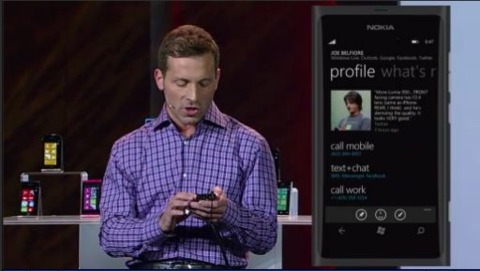
[6:51] He's now showing Bing integration in Metro. Have we mentioned that this operating system has literally been out for months?
[6:52] He searches for a restaurant from nearby choices, selects it, and he finds location, reviews, phone number, and reservation apps.
[6:52] All right, it looks like the Metro pitch is over.
[6:52] Now, Seacrest and Ballmer are talking about hardware.
[6:53] Ballmer says Samsung, LG, Nokia, and others are making Windows phones.
[6:53] Nokia Lumia 710 and 800 will be coming to Canada. And T-Mobile users will be able to buy the Nokia 710 this Wednesday in the US.
[6:53] The Nokia 800 is coming in the next few months.
[6:54] Ballmer then unveils the Nokia Lumia 900, which has a 4G LTE network.
[6:54] It's on the AT&T network; it will be "heavily promoted" in the next few months in AT&T stores, Ballmer says.
[6:55] There's more, Ballmer says. He then shows the HTC Titan 2.
[6:55] It launched today, and it works on AT&T's 4G LTE network.
[6:55] It has a 16-megapixel camera built in.
[6:55] Over 16,000 apps published in the Windows Marketplace and are growing by about 300 every day.
[6:56] Windows PCs is the next topic of conversation.
[6:56] Ballmer is talking about the change that Windows has undergone, and the innovation it has spurred.
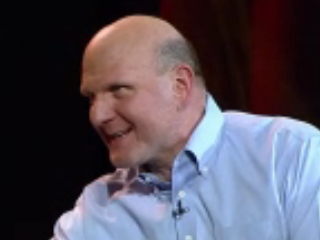
[6:57] There are over 1.3 billion Windows PCs in use, making it the most popular smart device on the planet.
[6:57] Things change, and people don't want to compromise on what they have today, Ballmer says.
[6:58] Windows 8 is a reimagining of the operating system, he says.
[6:58] But first, Windows 7 hardware.
[6:59] Ballmer cues up a sizzle reel of Windows 7 PCs.

[7:00] These include the Sony Vaio Z, Asus Zenbook, Acer Aspire 3S, Toshiba Protege, Dell XPS, Lenovo, Samsung 9 Series, HP Envy 14, and others.
[7:01] Chief marketing officer of Windows, Tami Reller, comes out on stage.
[7:01] She begins with Windows 8, which was introduced at CES 2011.
[7:02] The operating system is designed to deliver a "no-compromise" experience, combining the potential of a tablet with the power of a PC, she says.
[7:02] It combines what people want to do and need to do, she says. Demo time!
[7:02] The Windows 8 lock screen looks a lot like Metro's lock screen.
[7:02] There are icons for new email, messages, and calendar updates.
[7:03] Picture password is a new way to unlock the PC. Essentially, she identifies the correct places to click on a family photo.
[7:03] Windows 8 desktop also looks like the Metro interface.

[7:04] It's dramatically different from the Windows you know and...love?
[7:04] She opens a finger-painting app, and it takes over the tile-based screen.
[7:05] Prototype Aardvark is what she calls the current build.
[7:05] A wide range of PCs and tablets will support Windows 8, she says, and Microsoft is working with AMD, Intel, and various hardware manufacturers to see this happen.
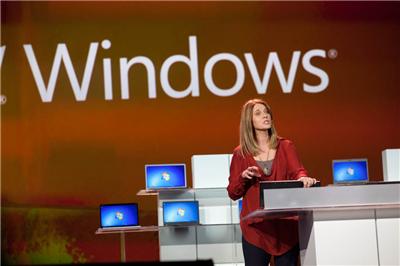
[7:06] Metro-style tile apps can be used with touch, mouse, and keyboard.
[7:06] She's now showing the Apps store.
[7:07] The Windows Store has free apps, trial apps, and apps that can be purchased.
[7:07] The Windows Store looks a lot like Xbox Live's new interface, for those looking for a different touch point.
[7:07] She opens Cut the Rope.
[7:08] She plays a few rounds and then switches out to a different app.
[7:08] The Windows Store will open in late February.
[7:09] It will be global, available in every language.
[7:10] The apps can be used on Windows PC and tablets.
[7:10] She shows how the user can use a keyboard or mouse wheel to cycle through the various tile screens.
[7:11] Hey, want to rename a group of tiles? Yep, you can do that.
[7:11] As was shown in the phone presentation, apps also interact with other apps.
[7:11] She opens a newsreader app and sees a Mac & Cheese recipe.
[7:12] She wants to share this with her husband so that he can make it for their kids.
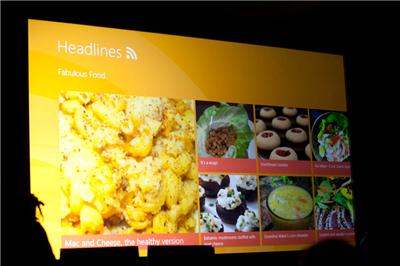
[7:12] She notes that she was able to share the recipe without leaving the app.
[7:13] Now, she opens a Word document, and she is able to see the newsreader app and her Word document at once.
[7:15] Metro-style Internet Explorer is then shown, and Keller emphasizes that it integrates seamlessly with other apps.
[7:15] Apparently, Web pages are responsive in IE.
[7:15] Swiping, or scrolling with the mouse wheel, takes her back to the Word document she was looking at.
[7:16] The next milestone in wide Windows 8 availability will come in February, she says.
[7:17] She's now showing the HP Envy Spectre Ultrabook.
[7:17] And then, a Samsung Series 9, which is less than 13mm thick and weighs about 2.5 pounds. It's now available in 15-inch screens.
[7:17] Dell apparently will be announcing a new UltraBook tomorrow. And Keller is done.
[7:18] Back to Seacrest and Ballmer, who says there are 500 million users on the planet for Windows 7.
[7:18] Ballmer emphasizes that every Windows 7 PC will be able to use Windows 8 on day one.
[7:19] Seacrest then introduces the...Tweet Choir?
[7:19] It's a group of gospel singers, it appears.
[7:20] They are singing tweets that have been sent out during the presentation.
[7:20] "Nonplussed" doesn't even begin to capture the feeling in the room.
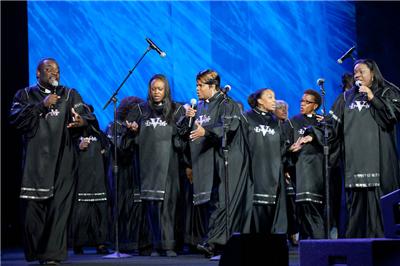
[7:22] I think one of the singers just name-checked GameSpot News. We'll take it!
[7:22] All right, we're finally talking about the Xbox.
[7:23] Ballmer says that the Xbox represents the best part of Microsoft's DNA.
[7:23] There are now over 66 million Xbox users.
[7:23] There are more than 40 million Xbox Live subscribers, Ballmer says.
[7:24] Some use Xbox 360 for games. More and more people use it as an entertainment hub, he says.
[7:25] The Kinect is a big part of the Xbox, Ballmer says. Or perhaps, reiterates.
[7:25] 18 million units of the Kinect have now been shipped.
[7:25] Greg Davison comes out to talk about the Xbox.

[7:26] It looks like we're going to get a rehash of December's New Xbox Experience, which has the tile-style Metro interface.
[7:26] Davison shows off the device's voice-recognition functionality.
[7:26] The Xbox responds quickly to his commands.
[7:28] He's doing more Bing searches, which go through Xbox Live to find his requests.
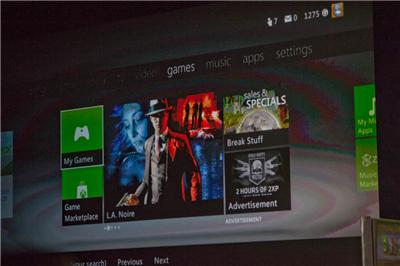
[7:28] Xbox Bing Josh Duhamel, he says, bringing up a variety of movies in which the Dark of the Moon actor was in.
[7:29] He pulls out a Nokia 900, which apparently has Xbox functionality.
[7:30] He can open the ESPN app and check in on the BCS game.
[7:30] Alabama is up 12-0, for those wondering.
[7:30] He then uses his voice to return to the Xbox Live hub.
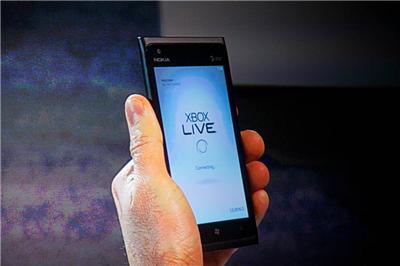
[7:31] Comcast is coming soon, bringing with it Xfinity.
[7:31] Microsoft has also partnered with News Corp., bringing with it Fox, The Wall Street Journal, and more.
[7:31] The News Corp. apps are coming in 2012.
[7:32] Davison said that Microsoft is working on new experiences, in collaboration with famous content creators.
[7:33] He introduces Jamie Bower, as well as a small child, to talk about Sesame Street TV.
[7:33] It uses the Kinect and has a two-way element, she says.
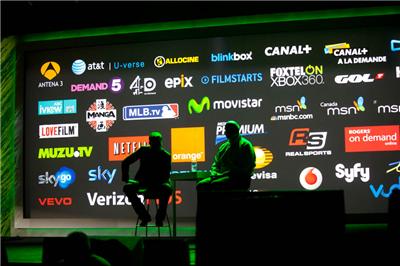
[7:33] They take current episodes in Sesame Street's season, and kids can now interact with the puppets.
[7:35] The game involves the child interacting with the puppet onscreen (Grover), tossing coconuts into a box.
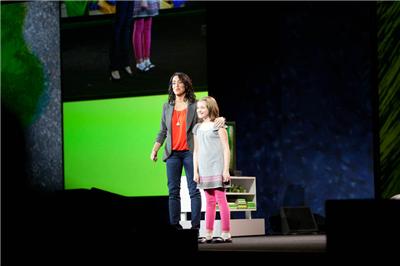
[7:37] The coconut-throwing segment lasts a while before they switch to another demo.
[7:37] Next up is a trip to Elmo's World, with the child dancing along with Elmo.
[7:38] Look, if you have a kid, this thing is probably going to be pretty cool.
[7:38] It's coming later this year.
[7:39] Seacrest and Ballmer are now talking about uses for the Kinect outside of the gaming spectrum.
[7:39] They cue up a video of people using the Kinect for classroom science, robotics, music, and more.
[7:39] Ballmer announces that the Kinect is coming to Windows on February 1.
[7:40] They are working with 200 companies, including Mattel, American Express, and many others.
[7:40] He's talking about Sync, which is now in 4 million vehicles.
[7:41] Office 2010 is the fastest-selling version of the product in company history.
[7:42] Incidentally, Amazon's product page for Kinect for Windows says it will sell for $250: http://www.amazon.com/exec/obidos/ASIN/B006UIS53K/34a6-20/
[7:42] Ballmer talks up Skype, which Microsoft acquired last year, and boasts 200 million users.
[7:42] Bing has reached 30 percent market share, in collaboration with Yahoo!.
[7:43] Ballmer is summarizing, looks like we're almost done. Nothing's bigger to Microsoft than Windows 8, he says.
[7:44] OK, that's it. SEACREST OUT!
Got a news tip or want to contact us directly? Email news@gamespot.com
Join the conversation